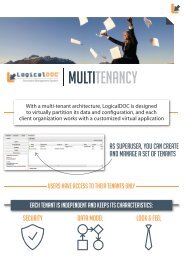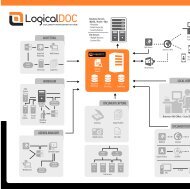LogicalDOC Clustering
A LogicalDOC Cluster is a number of computers working together to ensure a document management system is available and performing efficiently. The computers in the network exist independently but are connected to maximize the performance of the system.
A LogicalDOC Cluster is a number of computers working together to ensure a document management system is available and performing efficiently. The computers in the network exist independently but are connected to maximize the performance of the system.
Create successful ePaper yourself
Turn your PDF publications into a flip-book with our unique Google optimized e-Paper software.
CLUSTERING<br />
CLUSTERING<br />
CLUSTERING<br />
CLUSTERING<br />
CLUSTERING<br />
CLUSTERING<br />
CLUSTERING<br />
CLUSTERING<br />
CLUSTERING<br />
CLUSTERING
INTRODUCTION<br />
<strong>LogicalDOC</strong> is a platform that enables users to efficiently<br />
handle file search, entry, and retrieval.<br />
With keywords and parameters, users with access can find<br />
the files they need and access them simultaneously.<br />
Whether Enterprise, Business,<br />
Community, or Cloud,<br />
<strong>LogicalDOC</strong> has products that<br />
meet the needs of<br />
specific groups of users.<br />
<strong>LogicalDOC</strong>’s system is designed<br />
to ensure the availability of and<br />
easy access to files across<br />
organizations without disruptions. While we have many<br />
products to achieve this, clusters are one of the ways<br />
we at <strong>LogicalDOC</strong> ensure the efficiency of<br />
organizational systems.<br />
1
WHAT IS A CLUSTER<br />
A <strong>LogicalDOC</strong> Cluster is a number of computers<br />
working together to ensure a document management<br />
system is available and performing efficiently.<br />
The computers in the network exist independently but are<br />
connected to maximize the performance of the system.<br />
2
Why Is <strong>Clustering</strong> Relevant ?<br />
A node in the cluster is a server with an instance of<br />
<strong>LogicalDOC</strong> installed, where cables and software<br />
connect the clustered nodes.<br />
“The use of clustering architecture ensures<br />
that failure at one node does not lead<br />
to a failure of the entire system.”<br />
Once a particular node fails, another node instantly<br />
begins to provide the service. Since the nodes are<br />
connected one to the other, service disruptions<br />
can be mitigated.<br />
3
<strong>LogicalDOC</strong> Implements <strong>Clustering</strong><br />
With Three <strong>Clustering</strong> Architectures<br />
<strong>LogicalDOC</strong> approaches <strong>Clustering</strong> in three different ways.<br />
Each clustering architecture supported by <strong>LogicalDOC</strong><br />
is designed to meet specific use cases and needs.<br />
These architectures are namely:<br />
1. Best Performance<br />
2. High Availability<br />
3. Disaster Recovery<br />
4
Best<br />
Performance<br />
Architecture<br />
This clustering architecture is best suited for systems<br />
where a large document repository to index exists along<br />
with many users accessing these documents concurrently.<br />
If a single node is used to implement such a system,<br />
performance will be slow, and failures will be likely<br />
even if improvements are made on the node.<br />
“Best performance architecture exists to allow<br />
for the best performance by distributing<br />
the RAM and CPU loads among<br />
the nodes in the cluster”<br />
This allows each node to perform optimally without bearing<br />
too much load. However, there must be a hardware balancer<br />
to distribute requests evenly among the nodes and at least<br />
two <strong>LogicalDOC</strong> instances on separate nodes in the cluster.<br />
This architecture ensures that the response time when requests<br />
are made is minimized<br />
5
Implementing Best Performance Cluster<br />
With a Local File System<br />
The design when using a local file system requires:<br />
1<br />
Load Balancer<br />
This component is responsible for<br />
distributing requests evenly to<br />
the nodes in the cluster.<br />
It can be hardware or software.<br />
2<br />
<strong>LogicalDOC</strong> Node<br />
This node is an instance<br />
of <strong>LogicalDOC</strong> installed<br />
on a dedicated physical<br />
or virtual server.<br />
3<br />
Local File<br />
System<br />
4<br />
Database<br />
Server<br />
This is a storage device that acts<br />
as the file system. It is attached to<br />
a single node and is not shared with<br />
other nodes in the cluster.<br />
This can be a node in the cluster or<br />
a separate cluster of database<br />
servers. The database server is<br />
shared among all the nodes in<br />
the cluster.<br />
6
Implementing Best Performance Cluster<br />
With a Local File System<br />
Documents in this system are stored physically across nodes.<br />
When a request is made and sent to a node, but it cannot<br />
find it on it locally, it will request it from other nodes. To ensure<br />
nodes reduce search time, this system runs a federated search.<br />
“To reduce traffic in the LAN, it is recommended<br />
that the Cache option is activated while<br />
each cluster node is configured”<br />
7
Implementing Best Performance Cluster<br />
With a Shared File System<br />
“The design uses a Load Balancer,<br />
<strong>LogicalDOC</strong> Node, Local File System,<br />
and Database servers like the implementation<br />
with a local file system”<br />
This design, however, includes an additional component:<br />
Shared File System: This system is shared by all nodes<br />
in the cluster. This does not disrupt the existence of the Local<br />
File System attached to single nodes.<br />
Most resources are shared among all nodes, but each still<br />
has a local and partial index as a full search cannot<br />
be placed inside the shared file system.<br />
8
HIGH<br />
AVAILABILITY<br />
ARCHITECTURE<br />
High Availability Architecture is designed for<br />
systems that require minimal system interruptions.<br />
This can be because document management is business-critical, and<br />
any disruptions can lead to significant problems. It shares similar<br />
components with the Best Performance architecture, but some<br />
components have a different function here.<br />
9
1<br />
Load Balancer<br />
This hardware or software component<br />
notes when the main node is down<br />
and directs traffic to the<br />
secondary node.<br />
2<br />
Main Node<br />
This instance of <strong>LogicalDOC</strong><br />
on a server is the active<br />
recipient of traffic.<br />
It can either be a single node<br />
or a Best Performance Cluster.<br />
3<br />
Secondary<br />
Node<br />
This node is on hand to handle<br />
traffic in the event that the<br />
main node is out of service.<br />
Both nodes are in the same LAN.<br />
The Local File System and Database Server work like they do in<br />
the Best Performance Cluster. Although each node has a separate<br />
database and storage, they are both populated from the main node.<br />
This ensures that the system keeps running normally<br />
if the main node is out of service.<br />
10
DISASTER<br />
RECOVERY<br />
ARCHITECTURE<br />
This architecture replicates the design<br />
and capabilities of the High Availability design<br />
with very minimal differences.<br />
This architecture is designed to ensure the survival of the system<br />
if there is a serious challenge with the main node.<br />
The Disaster Recovery Architecture exists to allow operations<br />
to be restored in the occurrence of a disaster and is differentiated<br />
by the location of nodes. Here, the main node and secondary<br />
nodes are in separate geographic locations.<br />
11
Benefits of <strong>Clustering</strong> Architectures<br />
1<br />
Efficient document access<br />
and management<br />
Since documents are stored across<br />
nodes, they are faster to retrieve<br />
and concurrently accesse.<br />
2<br />
Reduced search time<br />
Due to its distributed nature,<br />
indexing files is faster since<br />
the search is federated.<br />
3<br />
Smooth business<br />
operations<br />
The existence of a secondary<br />
node in the high availability and<br />
disaster recovery systems ensures<br />
that component failures<br />
do not affect business operations.<br />
12
CONTACT US<br />
US Quarters<br />
<strong>LogicalDOC</strong><br />
14-25 Plaza Road<br />
Suite N-3-5<br />
Fair Lawn, NJ 07410<br />
USA<br />
+1 (800) 654 2827<br />
sales@logicaldoc.com<br />
German Quarters<br />
INDUS-VBS GmbH<br />
Bitzenhofer Weg. 3b<br />
86453 Dasing<br />
Germany<br />
+49 8205 969992<br />
Germany and Austria<br />
Head Quarters<br />
<strong>LogicalDOC</strong> Srl<br />
via Aldo Moro intema, 3 41012,<br />
Carpi Italy<br />
+39 059 5970906<br />
+39 059 640508<br />
info@logicaldoc.com


















